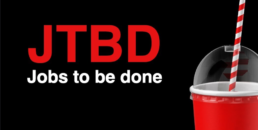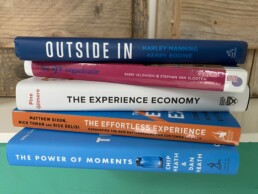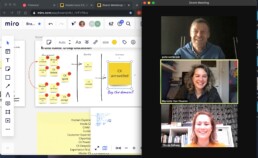Jobs to be done
What do your customers really want? What is their Job to be Done?
In Customer Experience it is essential to know what your customers really want. How else can you be sure you can meet or even exceed their expectations? In order to be sure, you need t o clearly define what your customers are trying to achieve; in other words: what is their job to be done when they interact with your company?
Why do customers buy a product or service? They want to hire you or use your product to get a job done! A well-known example is that a person buys a drill not because they want a drill, but because they are looking for a solution to get their job done: to get a hole in a wall to put up a painting!
Another example is that people aren’t looking to buy navigation apps, but need to get to their destination on time and the easiest solution to the task at hand, is a map or car radio or an app. Consider even listening to music to feel good! I’ve have had this “job” my entire life and yet I’ve used different solutions to get this job done over the years, from radio to vinyl records to CDs to iPods to now streaming music.
These examples tell us the 5 key elements of jobs to be done:
- They tell you what your customer really wants to achieve
And to achieve this, they need to hire a product or service to get their job done - These Jobs remain stable over time
They are mostly core needs that don’t change that quickly - Jobs are independent of the solution
A job is never a product or solution!
And as soon as a better solution comes in the market, then this solution takes over from the previous solution to get the job done - Jobs often fix a problem or solve a challenge
It helps to think of your customer’s frustrations to find out what problem or challenges they try to solve to think about jobs to be done - Jobs can be different in scope
- Jobs can be small or big; a small job could be that you want to pass some time during your lunch break (and to get that job done you might be reading this blog); a big job could be that you are looking for a career switch to Customer Experience (and to get that job done you might be reading this blog) > same solution for different jobs
- Jobs can be functional or emotional: a functional job could be that you want to drive safely and fast from A to B (and to get that job done you might buy a Tesla); two emotional jobs could be that you want to impress your friends, or maybe contribute to a greener planet (and to get those jobs done you might buy a Tesla) > again, the same solution for different jobs
Only companies that define their markets in jobs to be done, will survive! If you define your market in products, then you are working with a moving target. This will lead to failure. For examples of failures think of Blackberry who was in the markets of keyboard mobile devices, and Kodak who was in the market or film. These were not jobs to be done. Tech giants like Apple and Facebook knew the real jobs to be done: connect to other people and sharing memories > they came with the right solutions to meet those jobs.
We hope this clarifies and makes you think about jobs to be done instead of products. In a next blog we will come up with more examples and provide an easy template that helps you define your own jobs to be done! So… if your job to be done is to clearly define what your customers really want, then our next blog might be the solution you are looking for. Stay tuned!
CX must-reads!
CX must-reads!
It’s good to see you reading my blog! It means that you would like to further deepen your knowledge about Customer Experience (CX) and I promise you it will be a lot of fun. Quite some people have asked me for book recommendations with more information & inspiration on CX. That’s why I’ve created this list of my Top 5 favorite CX books.
- Outside In by Harley Manning and Kerry Bodine. A golden oldie (published in 2012). But this Forrester Research duo has managed to explain the six disciplines of CX in a very digestible way: strategy, customer insights, human centered design, CX metrics, customer centric organization and a customer obsessed culture. Plus it’s full of inspiring real-life examples.
- De 9+ organisatie. Van marketshare naar mindshare by Berry Veldhoen & Stephan van Slooten. This one is for Dutchies only (sorry!), that is – until Berry & Stephan publish an English version. Berry & Stephen were pioneers in the CX field in The Netherlands and work together at Customer & Employee Experience Consultancy firm Altuition. They have combined their CX experiences in this book, which describes what companies should do if they want to create a great customer experience: (1) figure out what’s relevant from the customer’s perspective, (2) create & do new things which make the difference in the emotions and experience of the customer and (3) organize these new things systematically as part of their total service & proposition package.
- The Experience Economy by Joseph Pine II and James H. Gilmore. Another golden oldie (their original article was published in 1998), but if you order the 2020 edition you’ll find a brand new foreword with recent practical examples. This book explains how we’ve moved from commodities to goods to services to experience. It also gives plenty of inspiration on how you can create brilliant experiences in your own context.
- The Effortless Experience by Matthew Dixon, Nick Toman en Rick Delisi. A refreshing book in this top 5, because these gentlemen are definitely not about creating “WOW-moments” of so-called “customer delight”. Simply solve your customers problems in a quick & easy way! There’s definitely some sense in that (as their research shows) – especially for company departments such as customer service.
- Last but not least, The Power of Moments written by brothers Chip & Dan Heath. In this book the mystery of experience is slowly unravelled – why, for example do we remember the best and worst moments of an experience and forget the rest? A psychological take on customer experience, supported by great practical examples.
I’m super curious of your opinion on these books and would love to hear if you think other CX books should be added to this list. Have fun reading!
Customer Experience Framework
CX Framework - 6 disciplines you need to master to excel in Customer Experience
More and more companies are now realizing that Customer Experience is the new competitive battleground for businesses. They vow to be customer focused and look at solving pre existing blind spots. But to break out of the find-and-fix cycle and find ways to differentiate yourself as a company, you need to make the next step: managing from your customer’s perspective in a systematic, repeatable and disciplined way. To do that, you need to routinely perform the 6 disciplines from the CX Framework. This Framework is being used by the CXPA (Customer Experience Professional Organization) and also by CX Unraveled in our offer of Deepdive Masterclasses. In this blog, I break down these 6 competences in an easy to digest way:
- CX Strategy
‘Good experiences don’t happen by accident, they are created by design’
This is your north star, or game plan: here you describe the intended CX you want to deliver, and you make sure it is linked to your overall company strategy, brand values and customer needs.
- Customer Understanding
‘Know what your customers want most and your company does best’
Key input for all other disciplines is your 360” customer view: Understanding who your customers are, their wants, needs, and how they perceive interactions with your company.
- Human Centered Design
‘Solve the right problem before you solve the problem right’
Following a structured design process is needed any time a pain point is fixed or a value point is created. Key is to have this process human centered, collaborative, and iterative.
- Customer Centric Organization
Key is to schedule your priorities, not to prioritize your schedule
Here it’s all about getting things done, and making sure that you manage CX in a disciplined and proactive way. Break the silos and have shared priorities and accountability.
- CX Metrics
If you can’t measure it, you can’t improve it
With the right metrics being put in your CX KPI framework, you can quantify your CX quality in a consistent manner, monitor your progress, and put CX at par with financial KPIs.
- Customer Obsessed Culture
Culture eats strategy for breakfast
This is your company DNA: shared values and behaviors of your staff needed to deliver great CX. This is what your employees do when you’re not in the room and is key in CX delivery.
More info per discipline can be found at the description section of our DeepDive Masterclasses. Additionally, in our upcoming blogs we will get back to some questions we often get on these disciplines. Questions such as: how are they related, where to start, is there a needed order in development, how mature are companies on the various elements and which topics are covered where?
The Making Of, Part 1
The Making Of, Part 1
What do you get when you put three Customer Experience Fanatics together…. so much enthusiasm about sharing their passion that they decide to start their own company! So we took upon ourselves the challenge of creating better life experiences by combining our forces with this huge amount of information on CX. But where to start and how to unravel.... 😆
How do we inspire people to become advocates for CX as well? How do we share our knowledge and expertise, and motivate and activate people at the same time?
As CX professionals we of course first took into account our customers needs. We can imagine that our customers have heard about Customer Experience but do not know where to start practicing it. Or they already work in the field and would like to learn more. Or their company is in need of structured CX implementation. Bottom line, there is so much information available and it is all linked to each other and intertwined. It might even be chaotic, discovering how to unravel all of this and finding your own way to bring it into practice.
Well that is exactly where we want to step in. Yes we are the No Guts No Glory kinda group, who want to make our passion your passion as well. We not only want to share our knowledge and expertise, we love to share it with you in a fun and practical way. We are interested in your CX journey and how we can help with a personalized track. We also challenge you to think out of the box and put into practice tomorrow what you learned from us today. Do you see some brand values in this text already…?
Haha now how to translate this into a brand name… well we went through a whole process of aligning, connecting, philosophizing, dreaming, evaluating, researching and feeling. We love to work in MIRO, an online collaboration tool. And with the help of the template https://miro.com/miroverse/minimum-viable-brand-workshop/ We finally decided on CX UNRAVELED. In the picture you see this very special moment!



